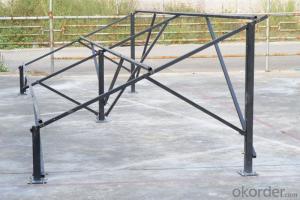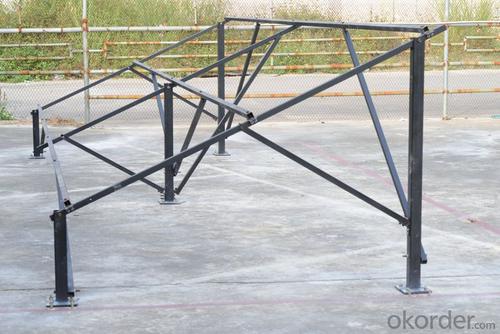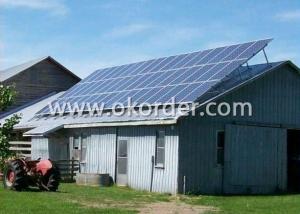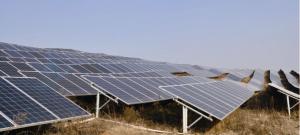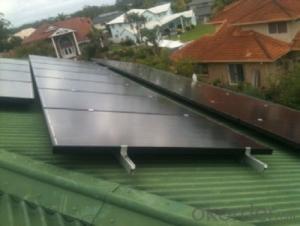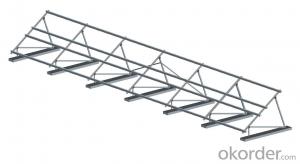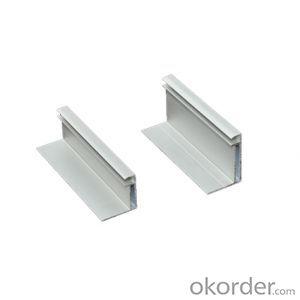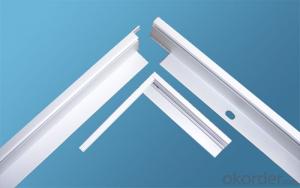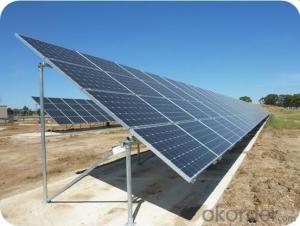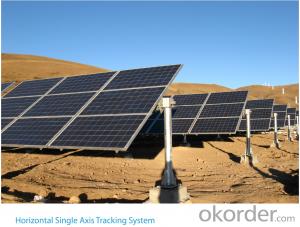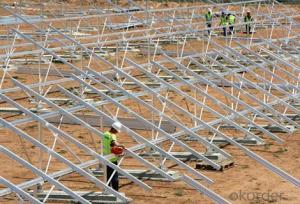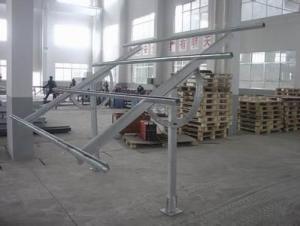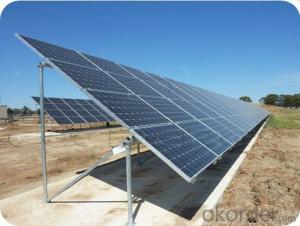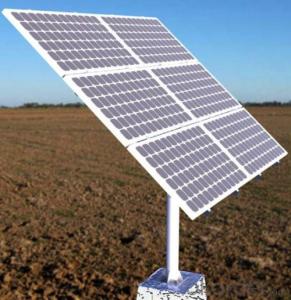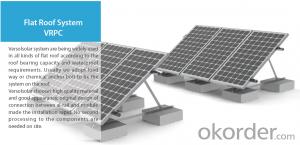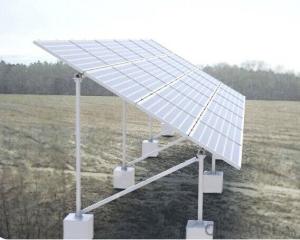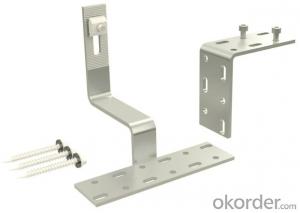Rv Solar Mounting Systems - Solar Panel Mounting System TT-RK-02
- Loading Port:
- Shanghai
- Payment Terms:
- TT OR LC
- Min Order Qty:
- -
- Supply Capability:
- 50万套 set/month
OKorder Service Pledge
OKorder Financial Service
You Might Also Like
PV Mounting brackets are special solar photovoltaic systemfor placing, installing, fixing the solar panel design. Generally materials arealuminum, steel structure, stainless steel. PV mounting products at groundmounting system, flat roof mounting system, adjustable angle roof rack system,inclined roof rack system, column bracket system.
The Ground Mounting System including concret basement sysytemand steel pipe sysytem, Titanergy provides total solution for flat or pitchedroof with patent products.On the basis of the given project data, specificnational standards and guidelines, Titanergy will calculate the completestructural analysis and create a complete project plan to make sure reliablestructural safety.We provide high quality HDG steel and aluminum products forthe ground mounting sysytem,witch can make sure the security and durability ofthe project.
Features and Advantages
n The rail bracket is easy to install, just use simple tools(eg, Allen wrench) can be easily installed. Rail connecting member can freelyadjust the length, the stent may be pre-installed on the roof, and thenappropriately adjusted according to the size of the solar panel.
n The combination of strong, aluminum rails and card blocks fora variety of venues and a variety of materials roofs (such as metal, ceramicand other kinds of tile surface)
n Component compatibility, and rail can meet PV modules fromdifferent manufacturers.
n accuracy, the length of the rail to the nearest millimeter,the construction process, not because of the length is too long or too shortfor the second cut.
n flexible assembly, rail hooks can adjust the spacing modulearray and tile has been installed successfully address the uneven roofconstruction led to difficult problems.
n design standards, product design and development process instrict accordance with GB, the German standards and other internationalstandards to ensure products reach the world advanced level.
n Quality assurance, the stent main material is high-qualityaluminum and stainless steel, effectively prevent corrosion of oxidation.Products can be recycled, reducing environmental pollution.
n Carried out strictly according to the current specificnational standards
n Perfectly optimized components and complete structuralanalysis for the sysytem
n High corrosion resisitance ensure the stability and highdurability
n Total test and certification make sure the high quality ofthe products
n Maximum pre-assembled in factory,quick mounting onsite,timesaving
10-year durability warranty
Technical Data
n Design Period:25 years
n Installation Site: Open area
n Array Angle:10°~60°
n ModuleType:Framed or unframed
n Material:Q235B,Al 6063-T5,Al 6005-T5,StainlessSteel A2-70
n Coating:HDG/Anodised
- Q: Are there any specific requirements for installing a solar mounting system on a rooftop with HVAC units?
- Yes, there are specific requirements for installing a solar mounting system on a rooftop with HVAC units. These requirements typically include ensuring that the solar panels and mounting structure do not obstruct or interfere with the HVAC units' functionality and maintenance access. Additionally, proper engineering and design considerations must be taken into account to ensure that the added weight of the solar system does not exceed the rooftop's load-bearing capacity. It is crucial to consult with a professional solar installer and obtain necessary permits to meet local building codes and regulations.
- Q: Are there any specific requirements for installing a solar mounting system on the ground?
- Yes, there are specific requirements for installing a solar mounting system on the ground. Some of the key requirements include a suitable location with sufficient space and unobstructed access to sunlight, a stable and level ground surface, proper soil conditions for anchoring the mounting system, compliance with local building codes and regulations, and consideration of any potential shading issues. Additionally, factors like wind speed, snow load, and seismic activity may also influence the design and installation of the mounting system.
- Q: Can solar mounting systems be installed on tile roofs?
- Yes, solar mounting systems can be installed on tile roofs. However, it is important to consider the specific type and condition of the tile roof, as well as the design and weight of the solar mounting system, to ensure proper installation and structural integrity. Professional expertise and assessment are recommended to determine the feasibility and suitability of installing solar mounting systems on tile roofs.
- Q: Can a solar mounting system be used in areas with heavy snowfall?
- Yes, a solar mounting system can be used in areas with heavy snowfall. However, it is essential to consider certain factors such as the design and strength of the mounting system, snow load requirements, and regular maintenance to ensure optimal performance and safety in such conditions.
- Q: What is the expected increase in energy efficiency with a solar mounting system?
- The expected increase in energy efficiency with a solar mounting system can vary depending on various factors such as the type of mounting system used, the orientation and tilt angle of the solar panels, and the location's climate and sunlight conditions. However, on average, a well-designed solar mounting system can increase energy efficiency by around 10-20% compared to solar panels installed without a mounting system.
- Q: Can a solar mounting system be installed on a rooftop with a metal panel roof?
- Yes, a solar mounting system can be installed on a rooftop with a metal panel roof. Metal roofs are actually a popular choice for solar installations due to their durability and compatibility with various mounting systems. The metal roof's strength and stability provide a secure foundation for the solar panels, and specialized mounting hardware can be used to attach the panels securely to the roof without causing any damage to the roof or compromising its structural integrity.
- Q: Can a solar mounting system be used in areas with high humidity?
- Yes, solar mounting systems can be used in areas with high humidity. However, it is important to select materials that are resistant to corrosion caused by humidity and take measures to prevent moisture buildup, as excessive moisture can potentially affect the performance and longevity of the solar panels.
- Q: Can a solar mounting system be used in areas with limited access to solar co-op programs?
- Yes, a solar mounting system can still be used in areas with limited access to solar co-op programs. Solar co-op programs are voluntary group purchasing initiatives that help homeowners and businesses procure solar installations at a reduced cost. However, even without access to these programs, individuals and businesses can still install solar panels and use a solar mounting system to harness solar energy for their own use. They may have to bear the full cost of installation and maintenance, but the benefits of clean and renewable energy can still be realized.
- Q: Can solar mounting systems be installed on green roofs or living walls?
- Yes, solar mounting systems can be installed on green roofs or living walls. These systems are designed to be versatile and can be adapted to various types of structures, including green roofs and living walls. However, certain considerations such as structural stability and weight load capacity may need to be taken into account during the installation process.
- Q: Can a solar mounting system be used in areas with feed-in tariff programs?
- Yes, a solar mounting system can be used in areas with feed-in tariff programs. In fact, feed-in tariff programs are designed to encourage the installation of renewable energy systems, including solar power, by providing financial incentives for the electricity generated and fed back into the grid. A solar mounting system is an essential component of a solar power system, enabling the secure and efficient installation of solar panels in various locations, including those eligible for feed-in tariff programs.
Send your message to us
Rv Solar Mounting Systems - Solar Panel Mounting System TT-RK-02
- Loading Port:
- Shanghai
- Payment Terms:
- TT OR LC
- Min Order Qty:
- -
- Supply Capability:
- 50万套 set/month
OKorder Service Pledge
OKorder Financial Service
Similar products
Hot products
Hot Searches
Related keywords
